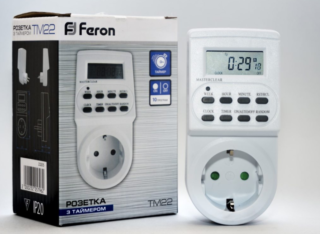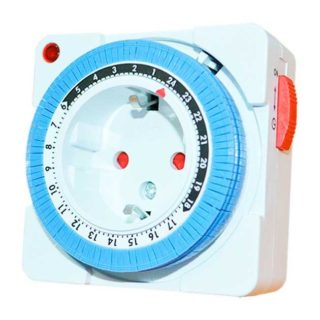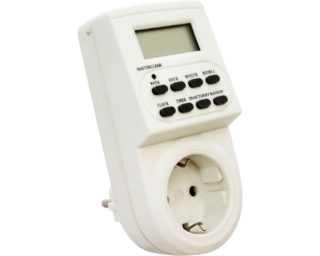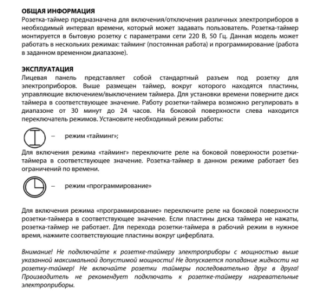Timer sockets are devices that are convenient to use for devices with a periodic on and off cycle. Suitable for pumps, heating devices, compressors, any household and lighting fixtures. They can also perform a protective function by simulating the presence of a person in the house. By the type of work, mechanical and electronic sockets are distinguished.
Principle of operation

Home automation is a useful feature. It saves electricity and eliminates manual power management. For these purposes, sockets with a timer are used. Outwardly, they look like a standard socket with buttons, displays or a lever.
Timed sockets are divided into 2 types - mechanical and electronic. Their principle of operation is similar, switching occurs due to the closure of contacts. In mechanical timers, control is carried out by a device that provides continuous rotational movement and closes / opens contacts. In electronic models, this function is performed by relay circuits that are controlled by the processor.
Use of sockets with a timer
Switches are multifunctional, so they can be used in a wide variety of areas. With a timer socket you can:
- control electrical appliances: household appliances, heating system, aquariums, watering plants;
- control the light - you can buy an outlet with the generation of random on and off for additional security in the house;
- manage agricultural activities: automatic watering of greenhouses, animal feeding, lighting;
- automation in production.
If your home has a multi-rate meter, you can save money. To do this, you need to program the switch so that it can perform some functions at night.
Advantages and disadvantages
Timed outlets have a number of advantages. These include:
- the ability to automate processes;
- simplification of work and saving of time;
- energy saving;
- can be connected to any industrial and household appliances;
- products with protection against moisture, dust and atmospheric precipitation can be used outdoors.
The main disadvantages depend on the type of outlet used:
- noisy and inaccurate operation of mechanical devices;
- lack of a built-in battery;
- high level of error.
The disadvantages include the dimensions of the devices - when connected to a double socket, it is almost impossible to use the second socket.
Features of choice
The choice of model depends on a number of criteria. When buying, you need to consider the following:
- The method for setting the interval is mechanical or electronic. For minimal functions with the need for automation for several hours, an inexpensive mechanical model is suitable. For complex complexes, an electronic timer is required.
- Automation time. In mechanical devices, it is limited to 24 hours. For “smart home” systems, expensive electronic sockets are used, for which the maximum rate can reach one month.
- Accuracy. Mechanical devices can operate with an error, and this must be taken into account. For simple actions - watering the plants, turning on the pump - high accuracy is not required, so an inexpensive model can be purchased.
- Load. There are timers for 10 A, 16 A, 40 A.It is selected depending on the total connected load.
- The number of programming lines. In expensive electronic sockets, you can control two or more devices.
- The degree of moisture and dust resistance. This parameter should be considered for outdoor products and appliances operating in humid conditions - bathroom, kitchen.
The price of the device must also be taken into account. It depends on the manufacturer, functionality, country of origin.
Timer types

Mechanical products are the simplest and cheapest devices. Consist of a drum with lever switches. They have a dial on which working periods are set.
The advantages of mechanical outlets include:
- low price;
- ease of use.
Disadvantages:
- exist only with a daily setting, so they need to be re-configured every day;
- inaccuracy of work;
- dependence on an external power source and the risk of breakdown in an emergency power outage.
Electronic devices have a more complex circuit and assembly. They provide more opportunities for the automation of equipment. There are models in which you do not need to re-install for a period of up to one month. Setting an electronic timer is more difficult than a mechanical one. First, you need to think over the sequence of actions to be performed and in advance calculate the intervals in which the switch will operate.

Benefits:
- automation for up to a month;
- the ability to set and regulate the time by minutes;
- independence from power supply;
- long battery life - some models can work more than 100 hours;
- presence of an option to simulate presence;
- several devices can be connected (depending on the number of channels on the switch);
- extended functionality.
Disadvantages:
- high price;
- the complexity of the setup;
- does not work well when connecting an inductive load;
- independence from the mains voltage can lead to the fact that in the event of an emergency power outage, the timer will execute its program, and the controlled device will not work.
Electronic smart timers have 4 operating modes: off, on, automatic, presence mode.
Setting the socket timers

With mechanical control, tuning is performed by a drum. It has a temporary markup, with the help of which the required period is set. How to use a mechanical timer socket and set the time:
- set the actual time using the rotating wheel (you need to rotate it clockwise);
- press the numeric keys, setting the appropriate turn-on period;
- connect the device to the socket.
To set up the electronic timer, you first need to draw up a weekly schedule for the operation of the device, and then carefully set the calculated parameters. You can set the desired period using the buttons to the right, left, up, down, delete, activate, countdown, reset. You can see the adjusted time on the LED screen.
Rules for setting up an electronic socket with a timer:
- pre-charging the battery;
- resetting the previous timer settings, if any;
- designation of the actual day of the week and time;
- setting the frequency of switching on and off using the buttons;
- press "time" to display the current time;
- connecting the timer to the network;
- connecting the device.
It is important to ensure that the specified programs in the electrical outlet do not overlap.
Possible problems
Most often, problems arise precisely in the electronic timer. Less common failures in mechanical products. The main types of problems:
- The program on the electronic timer socket is out of order. The main reason is poor or complete incompatibility with a household appliance. This is especially true for devices with inductive load. When the relay opens, a voltage remains, which gives out a spark and interferes with the timer board.The problem can be solved by replacing the electronic timer with a mechanical one to work with an inductive load. You can also connect a device with a non-inductive load in parallel - for example, a lamp. The program is restored by completely resetting and re-setting the socket timer.
- Connecting appliances with a power higher than 3.5 kW to a mechanical socket. The contacts may burn out, so it is important to correctly calculate the connected load.
- The lack of response to switching on and off may be due to the activation of the lock button. It needs to be set to an inactive state.
Each device comes with instructions in Russian. You should familiarize yourself with it before setting the settings and in case of errors and failures.
A socket with an electronic or mechanical timer is a device designed to automate processes in the house. With its help, you can set the operating mode of household appliances, automatically water the plants at the right time, create the effect of presence for additional safety. The principle of operation of both devices is the same, only the control method and setting differ.








